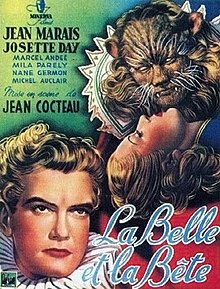La Belle et La Bete is a French film released in 1946. Written by Jean Cocteau, it is the original Beauty and The Beast, so the story is similar: a young girl takes her father's place as prisoner in a castle with a beast. The film has a surreal mix of elements in the set design, including hands holding candlesticks on the walls and statues that move. What makes La Belle et La Bete even more of an achievement is that all of the effects in the film were done without the use of any technology, instead relying on the skills of makeup artists, set design and costume.
 |
| Fig. 1 |
Much different from the more modern films, "Cocteau uses haunting images and bold Freudian symbols to suggest that emotions are at a boil in the subconscious of his characters." (Ebert, 1999). You can see just how much thought has been put into the set design, from the extravagant costumes to the elegant castle at The Beast resides in. Symbolism is used throughout the film to covey the thoughts of the characters, like spilled pearls or knives which are more than just an object: they have completely different meanings, and certainly shouldn't be taken at face value.
 |
| Fig. 2 |
Despite the erotic connotations throughout the film, there is still the strong sense of fantasy and magic, something which is later replicated in the Disney film. Described as being full of "wonder and mystery" (Brooks, 2014), La Belle et La Bete transports the audience to another world, with magical objects, a huge and beautiful castle, and a heart-warming love story. This is something that the audience of 1946 would have wanted, after all, France has just been ravaged by the Nazis in WW2. This child-like theme continues throughout the film, not only through the beautiful cinematic shots, but the use of sound and music. Although the movie doesn't have a stereotypically 'happy' ending, it still leaves the viewer satisfied at the end of the story. Even though we don't know what will happen to Belle's family, or even Belle herself, there's something about Belle and The Beast just floating away before the end credits that leaves the audience feeling like the story is complete.
 |
| Fig, 3 |
The film is bold and simple, and Cocteau uses his skills to work on "weaving a priceless fabric of subtle images." (Crowther, 1947). La Belle et La Bete, despite its underlying sexual messages, is, at heart, a film about a woman falling in love with an unlikely suitor, full of fantastical props, a beautiful castle, and a story that transports the audience to another world.
Brooks, X (2014). "La Belle et la Bête – review" In The Guardian [online]. Available at: https://www.theguardian.com/film/2014/jan/05/la-belle-et-la-bete-remastered-cocteau-review
Crowther, B (1947). "THE SCREEN IN REVIEW" In The New York Times [online]. Available at: http://www.nytimes.com/movie/review?res=9B03EFD71E3EEE3BBC4C51DFB467838C659EDE
Ebert, R (1999). "Beauty and the Beast" In Roger Ebert [online]. Available at: https://www.rogerebert.com/reviews/great-movie-beauty-and-the-beast-1946
Fig. 1 - https://upload.wikimedia.org/wikipedia/en/thumb/a/a4/La_Belle_et_la_B%C3%AAte_film.jpg/220px-La_Belle_et_la_B%C3%AAte_film.jpg
Fig. 2 - https://brendancultfilms.files.wordpress.com/2011/12/screen-shot-2011-12-06-at-8-54-46-am.png
Fig. 3 - https://i.ytimg.com/vi/36MbmkriK2g/hqdefault.jpg



























